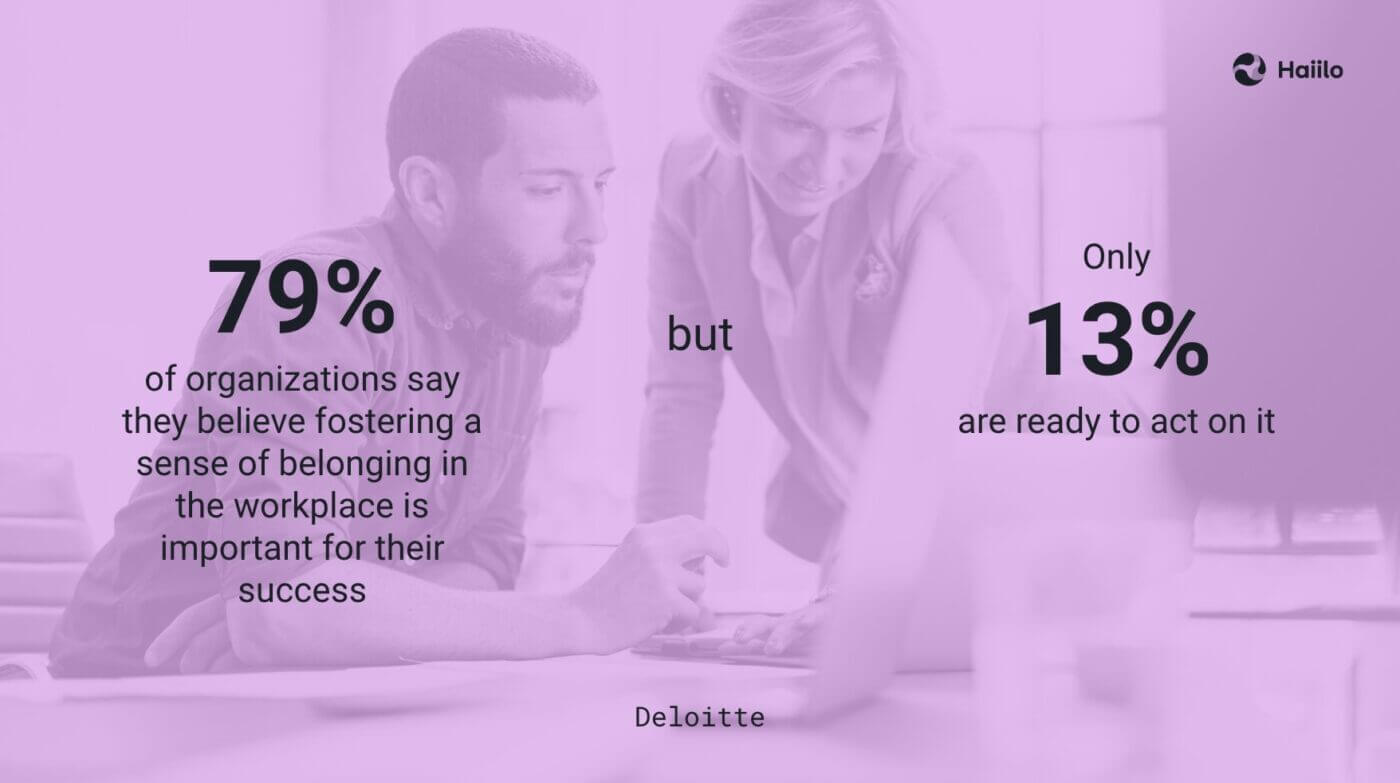Many experts predict that the sense of belonging in the workplace is the biggest driver of employee engagement, and we know that employee engagement is the biggest prerequisite for better employee performance, happiness, and retention.
So, it is not surprising that more and more organizations are investing additional resources into research and best practices for creating and nurturing a sense of belonging in their workplaces.
According to APA’s 2023 Work in America workforce survey, 94% of respondents reported that it’s somewhat or very important to them that their workplace be somewhere they feel they belong.

However, 30% of respondents reported their workplace doesn’t support them because of their identity, and 20% somewhat or strongly disagreed with the statement ‘When I’m at work, I feel like I belong.”
In this blog, we will define belonging, explain why it is so important, and share some of the best practices for ensuring that your employees feel like they belong to your organization and don’t feel excluded.
📚 Before we get started, take a look at our comprehensive guide for driving higher employee engagement.
How Experts Define Belonging
Let’s first define belonging. While there is no unique and globally accepted definition, here is how some experts define the sense of belonging:
- Shonna Waters, Vice President of Alliance Solutions at BetterUp, describes belonging as “when a person feels included and accepted for their authentic self.”
- Cambridge Dictionary defines belonging as “a feeling of being happy or comfortable as part of a particular group and having a good relationship with the other members of the group because they welcome you and accept you.”
- According to Deloitte, belonging is “a sense of comfort, connection, and contribution. It encompasses many routes to self-actualization, including issues of identity, social connection, and acceptance.”
- And our definition of belonging is “the feeling of being welcomed and a part of a group. Belonging is an ease of being with people and in a space where you feel safe and welcome to show up with your whole self.”
Create a sense of belonging in your organization with Haiilo!
Why Belonging In the Workplace Is So Important
There is a big gap between what organizations think about the sense of belonging and their readiness to act on it.
Research by Deloitte has identified a ‘readiness gap’ where 79% of organizations say they believe fostering a sense of belonging in the workplace is important for their success in the coming year, but only 13% are ready to act on it.

This is problematic because much research has already proved the value of having a sense of belonging in the workplace.
Specifically, a high sense of belonging increases job performance by as much as 56%. It reduces staff turnover risk by 50% and sick days by 75%. The research also discovered that among those with a high sense of belonging, raises doubled, and promotions were up by almost 20%. In terms of positive feedback, there was a 167% increase in those who said that they would recommend their company to others.
The 4 Elements of Belonging
Based on research by Coqual, a global, nonprofit think tank addressing bias and uncovering barriers to advancement for underrepresented populations in the workplace, there are 4 elements of belonging:
- Employees want to be seen— employees expect to be recognized, rewarded, and respected by their colleagues and their managers.
- Employees want to be connected—positive and authentic social interactions amongst peers, managers, and senior leaders.
- Employees want to be supported—leaders need to make sure to give employees what they need to get their work done.
- Employees want to be proud—when employees feel aligned with their workplace purpose, vision, and core company values.
📚 Take a look at our guide for creating an exceptional employee experience in your organization.
9 Ways to Create a Sense of Belonging In the Workplace
There are many ways to improve the sense of belonging in your organization, and here are some of the best practices that bring results.
1. Regularly Measure the Pulse of Your Workforce
Before you start thinking about improving the sense of belonging in your organization, it is important to regularly measure the current state of belongingness.
The easiest and most efficient way to do that is by distributing regular employee surveys.
Here are a few questions that will give you great insights about how your employees feel now and what it takes to improve the sense of belonging:
- Do you feel your values match those of this organization?
- Do you feel you are integral to the company’s goals?
- On a scale of one to five, how much do you feel coworkers care about you?
- Do you feel like you play a pivotal role in the organization?
- Do you feel like your unique characteristics are welcomed and celebrated?
- On a scale of one to five, how strongly do you feel like you can be your authentic self at work?
- On a scale of one to five, how open do you feel your colleagues are to different perspectives?
2. Think Beyond DEI
Some experts see belonging as the ‘missing ingredient’ of diversity and inclusion. While organizations are making significant efforts to accept diversity and foster inclusivity, a sense of belonging is ultimately the real evidence that the workplace is truly inclusive and diverse.
Where diversity, equity, and inclusion policies require organizations and employees to practice diversity and treat others fairly, creating a sense of belonging focuses on each person’s need to feel like they’re a part of the team.
For leaders, this means seeking out different perspectives, encouraging diversity of thought and opinion, taking into consideration individual needs, and including employees in the decision-making processes.
3. Nurture Trust and Transparency
Internal communications departments are the most responsible for building a culture of belonging and promoting workplace trust and transparency.
When everyone has access to the same information, they’re all on the same page.
Yet, 7 out of 10 employees say their organization fails to inform them of opportunities to promote inclusion in their day-to-day work. To better communicate genuine support for the idea of belonging, it is important to make everyone responsible for achieving clear DEI goals.
Managers and IC professionals should encourage employees to value what each person can bring to the table by caring for one another, advocating for everyone’s voice to be heard, and investing in their colleagues’ growth.
Only then will employees believe that they have a meaningful role in building a more inclusive workplace.
📹 Check our Masterclass about how to create a successful internal communications strategy.
4. Build Engaging and Connected Employee Communities
Creating a culture of community is critical for eliminating the sense of loneliness and disconnection that many hybrid and remote employees face today.
Even though organizations are trying hard to cultivate connections, 40% of people say that they feel isolated at work, resulting in lower organizational commitment and engagement.
Leaders, HR, and internal communications professionals can create internal communities in which employees share stories about how they have coped with workplace challenges and see what suggestions teammates have for improving the situation.
This approach can help workers not only navigate tricky workplace dynamics but also drive their own version of change, especially when the system isn’t working for everyone.
5. Create a Psychologically Safe Environment
Creating a workplace environment where employees feel safe to raise their concerns, ask questions, and freely provide bottom-up feedback is critical for creating a sense of belonging.
Employees who feel psychologically safe are more likely to have good relationships with their peers and managers, tend to go the extra mile to achieve great results, are better team players, and are unlikely to demonstrate quiet quitting behaviors.
Furthermore, building a culture of psychological safety is a critical component for promoting diversity, equity, and inclusion.
6. Ensure Fair Compensation, Benefits, and Incentives
Research suggests that fair benefits and initiatives can increase feelings of inclusion by up to 38%.
Workplace initiatives such as promoting diversity in succession planning and organizing company-wide celebratory events to highlight underrepresented groups (e.g., Women’s History Month) are highly effective at creating cultures of belonging.
As nicely put by Gartner:
Providing employees with benefits and initiatives that honor their unique contributions to the organization demonstrates that business success is directly linked to whether or not employees feel like they are accepted and belong.
7. Give Recognition and Show Appreciation
In research that asked people about what they felt would give them a sense of belonging, 59% of respondents said they wanted to be recognized for their accomplishments.

Many organizations think that they need a significant budget to get started with an employee recognition program. Often times, that’s not the case!
In fact, many employees prefer non-monetary over monetary recognition.
What’s important is that recognition is social and visible to everyone so that it’s easy for coworkers to celebrate each other’s success.
8. Put More Effort Into Onboarding
Onboarding is one of the most important phases of every employee’s journey, and it highly impacts the sense of belonging.
Welcoming new employees as a part of your onboarding process, introducing them to their peers, and enabling them to stay connected is a must!
For example, you can leverage your company’s intranet to introduce new hires on the news feed or you can have a weekly internal newsletter with short videos where new hires briefly introduce themselves to the entire workplace.
🔎 Learn more: Check out our article on the benefits of a proper employee onboarding program
9. Encourage Empathetic Leadership
Certain leadership styles can go a long way in developing and nurturing a sense of belonging within their teams.
Leaders who practice empathy are much better at building trust with their people and, hence, forming strong bonds. Naturally, empathy in the workplace helps create a stronger sense of belonging among people.
When leaders are able to connect deeply with their team members and understand unique perspectives and experiences, they can help people navigate the uncertainty and disruption that is likely to come.










